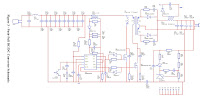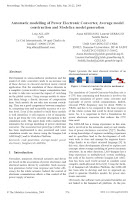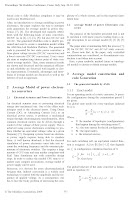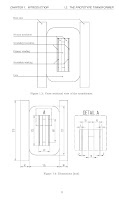
sexta-feira, 5 de março de 2010
quarta-feira, 24 de fevereiro de 2010
Design of a 320W Telecoms DC/DC converter.

Introduction
This report describes the design of a 320W Telecoms DC/DC converter. A push-pull forward
converter running with current mode control using the LM5030 from National Semiconductor
delivers high performance and small solution size. Custom planar magnetics from Payton
have been used throughout to reduce component build height, increase efficiency and aid
cooling.
This report contains target specification, schematic, bill of materials, magnetics design
information as well as a detailed design analysis. A full set of performance measurements is
also included taken from the prototype unit shown in Figure 1. Measurements include
conversion efficiency, power stage device temperature rise, line/load regulation, start-up
behaviour, transient load response and loop gain/phase characteristic.
terça-feira, 23 de fevereiro de 2010
IR Thermography
partly on an accurate knowledge of the power stage component
operating temperatures under extremes of load and input voltage.
This article demonstrates how the use of modern infra-red (IR)
imaging techniques can significantly enhance the design qualification
process and show up potential problems at a very early stage in
the product development cycle. The techniques highlighted are
applicable to any power converter system or electronic product
where knowledge of component operating temperatures is
important for reliability modelling and lifetime prediction.
By Dr. Iain Mosely, Technical Director, Converter Technology Ltd
One of the main limiting factors affecting the power capability and
reliability of any electronic power converter system is the operating
temperature of key power stage components. Excessive component
temperature will reduce product operating lifetimes and could result
in early field returns. Traditionally, thermocouples are used to
measure the operating temperature of components.
Whilst thermocouples can give very accurate temperature
measurements, they do have a few potential drawbacks:
• Thermocouples can pick up noise if they are placed near to power
components with high dv/dt switching waveforms present and this
can give misleading measurement results.
• Thermocouples will sink a small amount of heat away from the device
they are attached to. For physically small components, this can lead
to measurement inaccuracy.
• Thermocouples are often only placed on components which are
expected to show a reasonable temperature rise. Other components
may not be monitored at all and this could lead to problems if a
design error leads to a high operating temperature on a component
which hasn’t been monitored.
IR thermography is a non-contact measurement technique which
uses a calibrated infrared camera to form athermal image of the
system under test.
As the measurement technique is noncontact, the noise susceptibility
and heatsinking effects sometimes encounteredwith thermocouples
are no longer an issue. More importantly, an entire PCB can be imaged
which immediately shows up any hotspots or problem components that
may have otherwise been overlooked.
An example thermographic image ofa power converter is shown
in Figure 1.The power converter used has an issue with a snubber
TVS diode which can be seen to be running at >150°. Using the
thermal imaging camera is this example would immediately alert
the designer to a potential problem with the PSU before it reaches
the pre-production or production stage. The real value of thermography
in power electronic design is this ability to rapidly flag potential
design issues at a very early stage.
Infrared Imaging of Power Electronic Converters
Thermal management of electronic devices and packaging is important when dealing with high-voltage high-power systems as excessive device heating can have a catastrophic affect on the performance of a system and can lead to premature device and system failure. Therefore, it is necessary to accurately assess and characterize the thermal performance of power electronic components.
The use of thermal imaging equipment (infrared cameras) allows us to see beyond the visible into the invisible infrared. Our eyes are capable of detecting visible radiation but not infrared radiation. Infrared radiation is a form of electromagnetic radiation as are: visible light, radio waves, ultraviolet, and X-rays. Infrared radiation is longer in wavelength than visible light and is classified in a different waveband. Although few objects emit in the visible waveband, in the infrared waveband all objects emit. It is only that it cannot be seen with the physical eye. An infrared camera, therefore, becomes the "infrared eyes" into the infrared world. Infrared radiation is absorbed and emitted by objects. Absorptivity is the measure of how well an object or material absorbs radiation. Emissivity is the factor that correlates to the ability of an object to radiate infrared energy. In the way that visible light reflects off a mirror, infrared radiation reflects off many objects. For example, infrared radiation reflects clearly off metals such as aluminum. The fact that metals are good reflectors makes them poor emitters.
segunda-feira, 22 de fevereiro de 2010
Simulation, Design and Construction of High Voltage DC Power Supply at15 kV Output Using Voltage Multiplier Circuits
Simulation, Design and Construction of High Voltage DC Power Supply at
15 kV Output Using Voltage Multiplier Circuits
N. Mariun, D. Ismail, K. Anayet, N. Khan and M. Amran
School of Electrical System Engineering, Northern Malaysia University College of Engineering
01000 Kangar, Perlis, Malaysia.
Abstract: This study describes the details of high voltage DC power supply whose output voltage is 15
kV. In this study, we review the major aspects of the design of voltage multiplier circuits and
constructed a prototype power supply based on simulation, design and implementation of the hardware
works in the laboratory. Its simulation works done by using EMTDC PSCAD and PSPICE software.
Experimental results are presented to verify the simulation results.
domingo, 21 de fevereiro de 2010
Physics of Free Energy Device
There is no energy crisis in the world. Instead, there is amnesia in the minds of the scientists and the physicists.
Dipole (Anti)Gravity, Magnetic Gravity, true Gravitomagnetism

Although it should be obvious up to this point of the discussion regarding dipole gravity, I would like to present the succinct mathematical form of the static portion of the extended gravity potential for the rotating hemispherical (in general, longitudinal axially asymmetric) object, for the sake of our younger generation.
EVENT:2010:TOP 10 EXOTIC FREE ENERGY Technologies for Earth Transformation Conference
Directory:Perendev Power Developments Pty (Ltd)
sábado, 20 de fevereiro de 2010
Nikola Tesla biography 1/7
quinta-feira, 18 de fevereiro de 2010
NIKOLA TESLA - REDISCOVERY OF A GENIUS

Tesla - rediscovery of a genius
NIKOLA TESLA ES UNO DE LOS CIENTIFICOS QUE CAMBIO EL MUNDO MODERNO,SOBRE TODO CON SUS DESCUBRIMIENTO DEL ELECTROMAGNETISMO,EXISTEN HASTA HOY MUCHOS MITOS,EL PROBLEMA PERSONAL Y PROFESIONAL QUE TUVO CON TOMAS ALVA EDISON EN LA GENERAL ELECTRIC,YA QUE EL INVENTABA LOS DISPOSITIVOS Y OTRAS PERSONAS QUERIAN APODERARSE DE LAS PATENTES,REALMENTE HAY QUE INVESTIGAR PROFUNDAMENTE SU BIOGRAFIA PARA TENER UNA VISION REAL DE LA VIDA DE ESTE CONTROVERTIDO CIENTIFICO,UNA COSA ES CIERTA HOY EN DIA EXISTEN EN DIVERSAS PARTES DEL MUNDO CIENTIFICOS INVESTIGANDO TRABAJOS DE NIKOLA TESLA EN PARTICULAR EN EL AREA DEL PULSE ELECTROMAGNETIC.
quarta-feira, 17 de fevereiro de 2010
APC Symmetra PX250/500KW UPS Demo
As crônicas futuristas do novo livro de João Antonio Zuffo
Em 2038, você poderá ler esta reportagem por meio de seu clone virtual que estará interligado na grande Teia Global. Tudo isso enquanto você toma seu café da manhã preparado por robôs e, ao mesmo tempo, olha para uma vista virtual da torre Eiffel. Pelo menos é assim o futuro previsto no livro Flagrantes da vida no futuro, de João Antonio Zuffo, professor da Escola Politécnica (Poli) da USP.
O livro de Zuffo é uma ficção científica, que, segundo o autor, não está descompromissada com a evolução tecnológica que vemos hoje. “O tempo pode não ser exatamente este do livro, mas tenho certeza que as coisas citadas irão acontecer”, fala o professor.
terça-feira, 16 de fevereiro de 2010
Automotive Electromagnetic Compatibility

Components in Conductor Layouts
Sabine Alexandersson
Doctoral Dissertation in Industrial Electrical Engineering
Department of Industrial Electrical Engineering and Automation
2008-LUND UNIVERSITY
Abstract
The electronics in the automotive industry is facing a new era where safety
critical functions are electrified, as for example drive-by-wire technology. At
the same time as the number of electrical loads in the vehicles is increasing,
the time to market is decreasing. Full scale prototypes of a vehicle are often
only available at a late stage in the development process where changes are
rather costly. This implies that prediction and simulation of a system are of
importance and are useful already at an early stage of the development
process. There are economic benefits that can be gained by prediction and
simulation of the system such as: reduction of time to market, virtual tests,
virtual prototypes and optimization of electronic circuits with respect to
safety margins of filters.
The high number of electrical loads in the vehicle leads to different cable
harnesses routed along the body and chassis of the vehicle. These cable
harnesses will contain both power conductors and communication
conductors, routed close together. When conductors are routed close to each
other, a signal on one conductor can interfere with the signal on another
conductor. This phenomenon is called crosstalk.
Crosstalk can increase the noise levels, create unplanned spikes or destroy
data on nearby conductors. Hence it should always be a prime suspect in an
electromagnetic interference investigation or a candidate for prediction.
Crosstalk between two conductors is coupled by the mutual inductance and
capacitance. When these parameters are known, the crosstalk can be
estimated by using a circuit simulation.
The mutual inductance and capacitance between the conductors as well as the
self inductance and capacitance of each conductor depend on the
surrounding environment. This implies that the conductor layout is an
important factor when it comes to designing a system that is robust against
crosstalk.
Chapter 2
Automotive electromagnetic compatibility
Automatic modelling of Power Electronic Converter, Average model





Proceedings 7th Modelica Conference, Como, Italy, Sep. 20-22, 2009
Loig ALLAIN
LMS
La Cité Internationale, 84 quai Charles de
Gaulle,F- 69006 LYON
loig.allain@lmsintl.com
Automatic modelling of Power Electronic Converter, Average model
construction and Modelica model generation
Thermal modeling of a medium frequency transformer



| Author: | Kalle Ilves |
| Title: | Thermal Modelling of a Medium Frequency Transformer |
| School: | Royal Institute of Technology |
| Date: | March 2009 |
| Type: | MastersThesis |
Abstract
This thesis covers thermal modeling of a medium freuqency transformer. The
geometry of the transformer and the thermal properties of the di erent parts
are used to derive thermal resistances that can be put together in an equivalent
circuit describing the thermal system. The transformer is immersed in oil and
it is found that convective heat transfer through the oil must be included in the
model. The dynamic behaviour of the transformer is also modeled by including
thermal capacitances in the circuit.
The model is evaluated by measuring the primary winding and core temperature
while the transformer is heated. The primary winding temperature is measured
by measuring its electical resistance. The chosen method is discussed along
with the di erence between the measured and estimated response of the
thermal system
READ FULL THESIS HERE
Has the world really discovered the advantages of Brazilian automotive engineering?
By Thiago Struminski, Industry Analyst, Latin America -FROST & SULLIVAN
The Brazilian automotive engineering has a long standing tradition, it exists for over 50 years and the country unveils its 3rd generation of automotive engineers. Its competence was built by vehicle producers which over the 50s and 80s locally manufactured cars, long gone from their production plans in Europe and the U.S and required several adaptations for the local market. It is the case of GM's Opala model. The specific conditions of Brazil drove the need to search for unique solutions and created spaces for local development activities. The country has a wide territory, poor road conditions and in terms of temperature; the south of Brazil reaches -5 Celsius, and the north +40 Celsius. Vehicle producers have to take all of that into account when projecting the durability of a vehicle body. Therefore, the utilization of different materials is one of the ingredients to give a local face to the Brazilian Automotive Engineering. Later on, the development activities evolved to the derivation of vehicles conceived abroad such as the pick up Corsa and the Astra Sedan, originated from Germany.
Throughout its history, creativity and capacity to offer low cost solutions have always walked side to side with local automotive professionals. The local engineering culture was formed under strong cost pressures and requirements to increase productivity levels with limited resources. Such scenario has contributed to another very important differential: flexibility. The speed in terms of capturing the new trends and bringing it to new models is certainly a major competitive advantage in a time which product life cycles decrease with strong intensity.
The Brazilian automotive industry has been the pioneer in producing small pick ups and 1.0 liter engines. The latter has amazingly pushed forward the sales of popular vehicles in the early 90s and still accounts for 52 percent of all cars sold in the country.
However, the flagship automotive technology is related to alternative fuels. During the 70s, the oil crisis forced the Brazilian government to find solutions in order to diversify its energy matrix. The way out was to introduce gasoline blended with a high volume of ethanol; in order to foster the development of straight ethanol fueled vehicles. Later on in 2003, important suppliers such as Magneti Marelli, and Bosch, through some special electronic sensors developed in Brazil the flex fuel technology. In practical terms, the flex fuel allows the choice of fuel (at each vehicle refueling) according to characteristics of price, quality, performance or even fuel availability. Soon after its introduction in the Brazilian market, flex fuel vehicles reached 86 percent of market share in only four years. At the moment, local efforts are concentrated on Biodiesel which is already obligatory by Brazilian legislation.
In such a spirit, Brazil has successfully evolved from the tropicalization of products designed elsewhere, to the unit by unit construction of new vehicles. Finally, the Brazilian automotive industry has achieved a status of a global platform designer.
A critical point for the Brazilian automotive industry would be to speed up the process of involving engineers within development activities. Currently to capacitate a project coordinator to the automotive industry takes an average of 8 years. In order to be 50 percent more effective the ideal target is to reach a 2-3 year level.
The industry needs to enhance the attractiveness of working for the automotive industry and the engineering activity itself. Local associations such as SAE Brazil are trying to incentive newcomers at the very bottom of the education system creating technical courses for youngsters and fostering a culture of technology. It is essential for a country which lags behind in its educational system. Most developed countries have an average of 25 engineers per every 1000 thousand inhabitants; Brazil has much lower average than that. The percentage of graduated Brazilian Engineers in comparison to all graduated University students is also below international standard.
There are about 13,000 engineers engaged on the Brazilian automotive industry. The movement private sector/University has intensified over the recent years and promoted specific success stories such as GM/Politecnica, Ford/Unicamp, Fiat/PUC Minas and UFSC, but still has a lot to improve. Around 68 percent of the research groups involved in automotive are concentrated on the South/Southeast region. All the vehicle producer/University associations draw the example of the link Embraer/ITA. The Brazilian airplane manufacturer was the first local company to really speed up the development of specialized engineers giving them interesting career opportunities. Working with more than 4,000 engineers, with the assistance of the University it has manage to create a very innovative culture, allowing them to produce the latest technology and become world reference in terms of regional jets. As the example is followed by the automotive industry, results are starting to appear.
MIT lança programa de cooperação com o Brasil


Publicação de
Sociedade Brasileira para o Progresso da Ciência-CIENCIA E CULTURA
POLÍTICA DE C&T
Ciência e Cultura
ISSN 0009-6725 versão impressa
Cienc. Cult. v.62 n.1 São Paulo 2010
MIT lança programa de cooperação com o Brasil
Deixando um rastro de fumaça para trás, o Cristo Redentor apareceu estampado na capa da prestigiosa revista inglesa The Economist, que dedicou 14 páginas de uma edição de novembro de 2009 para uma reportagem especial sobre a decolagem dos negócios e finanças no Brasil. Sob o mesmo clima de otimismo, o Instituto de Tecnologia de Massachusetts (MIT) realizou, na mesma semana, a primeira sessão de orientação para alunos e pesquisadores interessados em participar do "MIT-Brazil", programa que prevê estágios de alunos do MIT em empresas, universidades e institutos de pesquisa brasileiros. Aliado a isso, projetos de colaboração em pesquisa e inovação entre Brasil e o instituto serão também incentivados. Demais atividades previstas no programa incluem a realização de conferências, workshops e palestras.
Lançado oficialmente em julho de 2009, o MIT-Brazil é a 11º Iniciativa Internacional em Ciência e Tecnologia do instituto, seu maior programa internacional, responsável pelo envio de cerca de 400 alunos por ano para diversos locais do mundo. O programa voltado para o Brasil se destaca por ser o primeiro da América do Sul, o segundo da América Latina, depois do México.
O estímulo para a parceria com o Brasil veio de Suzanne Berger, diretora geral dos programas, juntamente com Richard Locke, professor do Departamento de Ciência Política e da Escola de Administração Sloan, ambos do MIT. Locke, que já deu aula na Universidade Federal do Rio de Janeiro (UFRJ), divide a diretoria do programa com Ben Ross Schneider, professor do Departamento de Ciência Política do instituto.
Segundo Schneider, ao contrário dos programas tradicionais Brasil-EUA, o objetivo do "MIT-Brazil" não é só estudar o Brasil ou entender como o país funciona. "Temos problemas e desafios em comum, vamos trabalhar juntos e é nessa linha que esperamos desenvolver os projetos", diz. Outra diferença importante está no enfoque em ciência, engenharia e ciências sociais. Os programas já existentes são voltados, sobretudo, para literatura, cultura, música. Energia, meio ambiente, empreendedorismo e igualdade são as áreas de interesse listadas até o momento, mas pode haver outros interesses.
Um estudo que mediu o impacto e o papel empreendedor do MIT, em 2009, concluiu que, se as empresas ativas fundadas por seus alunos formassem uma nação independente, seus rendimentos seriam equivalentes aos da 17ª maior economia mundial, em estimativa conservadora. O estudo foi realizado pela Fundação Kauffman sob a orientação de Edward B. Roberts e Charles Eesley. Olhando para o empreendedorismo no Brasil, Schneider destaca a importância não só de grandes empresas brasileiras como a Vale, Embraer e JBS, mas também do aumento no número de pequenas empresas em fase inicial de implementação e organização que se observa atualmente no país.
Brasil e EUA estão fechando outras parcerias de cooperação científico-tecnológicas, incentivadas pelo ministro de Ciência e Tecnologia, Sérgio Rezende, que viajou com uma comitiva brasileira para Washington, em novembro de 2009.
O momento aponta para um futuro de cooperações profícuas. Até a viagem ao Brasil da presidente do MIT Susan Hockfield, prevista para 2011, muitas das parcerias possivelmente estarão concretizadas.
Universidade Estadual de Campinas
Labjor - Reitoria V - 3º Piso
CEP: 13083 - 970 Campinas SP Brasil
Tel: (19) 3521-2585/84/86
Fax: (19) 3521-2589
Tel: (19) 3289 3120 / 3788 7165
Fax: (19) 3788 7857
E-MAIL:
cienciaecultura@sbpcnet.org.br




































 JOSIL ARTISTA PLASTICO FORTALEZA CEARA BRASIL AV.HERACLITO GRAÇA 41 TEL(85)32542378
JOSIL ARTISTA PLASTICO FORTALEZA CEARA BRASIL AV.HERACLITO GRAÇA 41 TEL(85)32542378
















